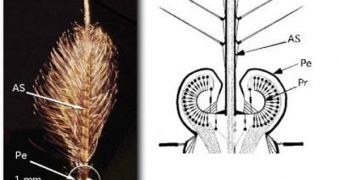Scientists working with a new mathematical model may have finally figured out how it is that mosquitoes can hear the faint sounds of a female's flapping wings, but not become deaf when hearing louder noises. The University of Bristol research team has managed to unlock some of the remarkable features, but highlights the fact that more work is needed before more conclusions become available. Details of the scientific study appear in the latest issue of the Journal of the Royal Society: Interface, e! Science News reports.
The active elements involved in mosquitoes' hearing are called scolopidia, and represent multiple individual sensory units. Insects have evolved various types of hearings, if compared with our own. However, their ultimate goals are the same as ours, to turn small energies of a transmitting sound wave into an electrical impulse. Acoustic energy may need a boost in mosquitoes, the researchers note, so it could be that scolopidia appeared to fulfill this very purpose. The sensory unit allows for a lot more of the auditory information to be converted into electrical signals, which are then transmitted to the insects' “central processing unit.”
Toxorhynchites brevipalpis, a Tanzanian mosquito species, was used as a reference point for the new study. The scientists created a simple microscopic mechanistic model of the amplification system that the insect had at its disposal. One of the simplest ways of describing the hearing apparatus and its modus operandi, the team says, is to compare it to a forced-damped oscillator, which is attached to a set of active threads, represented by the groups of scolopidia. When antenna oscillation reaches a critical amplitude, twitching in the threads close the communication channels, reducing the level of electric signals that reaches the mosquitoes.
“The numerical results presented also generate new questions. In our description of the system, for instance, all threads have the same material properties, but their impact on the dynamics of the antenna varies according to the spatial location of the threads: intuitively, an external thread induces a much larger torque than an internal one. However, the true physiology of the threads is more complex, due to the curved arrangement of Johnston's organ, and further research into the effect of the subsequent mechanical variation of each thread needs to be carried out,” UB researcher Dr. Daniele Avitabile explains. She is a research assistant in the university's Center for Applied Nonlinear Mathematics, in the Department of Engineering Maths.

 14 DAY TRIAL //
14 DAY TRIAL //